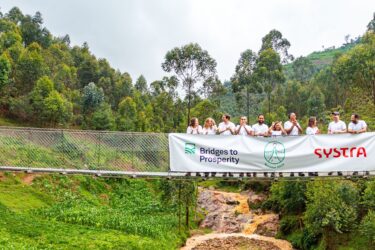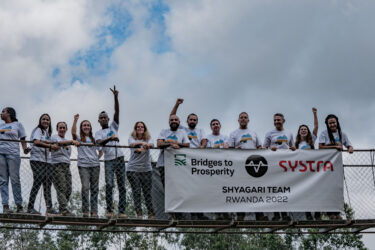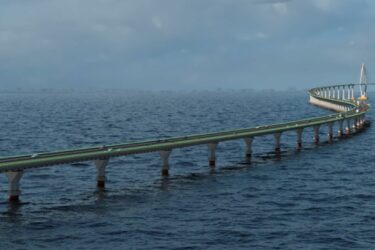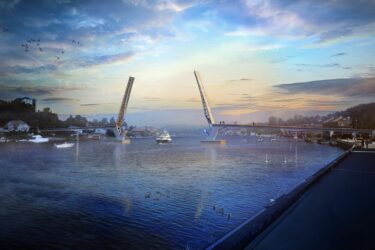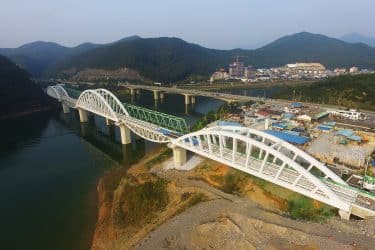The design of the Sheikh Jaber Al-Ahmad Al-Sabah Causeway is signed SYSTRA. This structure has transformed travel in the bay of Kuwait and holds the world record for the longest offshore section, with 34.1km of route built above the sea.
Subiyah Bridge connects the capital Kuwait City to the Subiyah area via one of the longest maritime road links in the world. This transport infrastructure project is one of the most iconic in the Middle East and measures a total of 48.5km, over two sections (Main Link and Doha Link).
This unique bridge transforms road travel for Kuwaitis, with a crossing of the bay reduced from 70 minutes to just 20 minutes, and will contribute to the development of the new city of Madinat Al-Hareer. This future zone of economic activity is set to create a central hub in the Gulf by 2030.
Background to a unique project
From 2013 to 2019, SYSTRA worked in a Design & Build partnership within the construction consortium formed by the South Korean company Hyundai E&C and the Kuwaiti firm CGCC. Our Group was entrusted with the complete design of the bridge and associated structures of the Main Link as follows:
- A maritime bridge of 26.4km;
- A cable-stayed bridge of 340m with a main span of 177m;
- A land bridge of around 4.5km ensuring the connection with the road networks of the Ghazali interchange;
- Two artificial islands, two reclamations, and two marinas;
- 30 buildings with a total surface area of 16,000m² destined to facilitate the maintenance management of the project’s infrastructure;
- An iconic panoramic tower, as well as all the electrical and mechanical systems.
SYSTRA also carried out the external control for the designs of the Doha Link for the South Korean manufacturer GS E&C.
A record-breaking, innovative and multisite bridge
The accumulation of non-standard elements and technical challenges to overcome in a desert and marine environment pushed SYSTRA to implement leading edge technical and economic solutions never used before on such a scale. For example, the option of monopiles to support the structure enabled stability in an unfavourable geological context, while significantly reducing seismic effects, the need for natural resources and the risk of concrete dispersion.
We also proposed a world first: the precast of the entire prestressed spans of 40 and 60m and 950 and 1,600 tonnes respectively using a pre-tension system in a dedicated casting yard. These construction methods were one of the keys to the project’s succcess and enabled the impacts on marine ecosystems as well as the construction risks associated with offshore works to be significantly reduced.
SYSTRA’s design work, carried out in only three years from 2013 to 2016, mobilised more than 250 experts. Spread over five countries (France, India, Kuwait, Korea, and Dubai), they produced almsot 15,000 drawings and more than 620 reports for this projet the multicultural coordination of which demonstrates SYSTRA’s ability to lead very large projects with all the necessary areas of expertise all over the world. This prowess was acknowledged by the Kuwait Chapter of the American Concrete Institute (ACI) which awarded SYSTRA the Special Award for Infrastructure Project 2017.
Some project figures:
Sheikh Jaber Al-Ahmad Al-Sabah Causeway:
- 48.5km for the maritime crossing
- 36.1km – Main Link
- 12.4km – Doha Link
- 34.1km of bridge at sea (35.9km with the ramps)
- 2 artificial islands of 30 hectares each
- 2 reclamations of around 30 and 60 hectares
- A construction cost of 3.6 billion dollars
- 5 years of studies and construction
Main Link:
- 34.1km of offshore section, a world record
- 1,510 bored piles
- 1,190 piers, 24 abutments
- 1,107 box girder spans and 4 spans of in-situ cast slab bridge
- 12 spans with 72 precast I-beams and in-situ slabs
- 2 orthotropic box girders of 164m in length for the cable-stayed bridge
 Australia
Australia  Brazil
Brazil  Canada
Canada  China
China  Denmark
Denmark  France
France  India
India  Indonesia
Indonesia  Ireland
Ireland  Italy
Italy  Malaysia
Malaysia  New Zealand
New Zealand  Norway
Norway  Poland
Poland  Saudi Arabia
Saudi Arabia  Singapore
Singapore  South Korea
South Korea  Sweden
Sweden  Taiwan
Taiwan  Thailand
Thailand  United Kingdom
United Kingdom  United States
United States  Vietnam
Vietnam 






